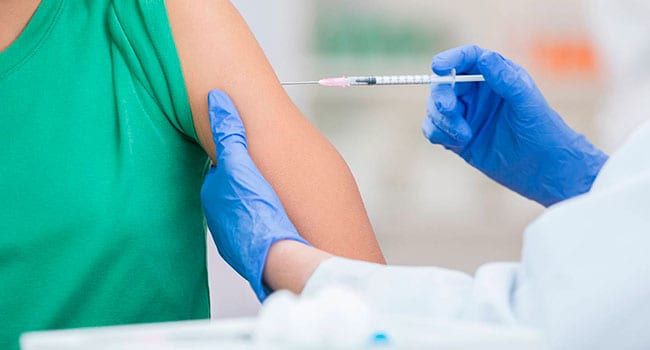A pharmacy researcher predicts more of us will roll up our sleeves for the influenza vaccine this fall thanks to the crash course we’ve all had recently on viruses and how to prevent them.
“Because of COVID-19, people are becoming a lot more aware of how susceptible they are to viruses and virus-caused infections, especially influenza,” said Scot Simpson, professor and chair in patient health management in the University of Alberta’s Faculty of Pharmacy and Pharmaceutical Sciences. “They realize it can be a severe infection and they are looking for ways to prevent it.”
“All this talk about a vaccine for COVID-19 has increased awareness that there are vaccines for other diseases.”
The Alberta government has purchased 1.96 million doses of influenza vaccine for its annual campaign, which begins Oct. 19. That’s enough to immunize 45 per cent of the province’s population, a significant increase over the 33 per cent who were vaccinated last year.
Most people will choose to get the shot at a pharmacy, Simpson said. During the 2018-19 flu season, 55 per cent of flu vaccines in Alberta were given by pharmacists, compared with the Canadian average of just 35 per cent.
Simpson credits this to the fact that Alberta pharmacists were among the first in Canada to earn the right to deliver drugs by injection, allowing for convenient access to immunization at community pharmacies.
“Even if you know you’re at risk and you know there’s a prevention option, if it’s not easy to get to, then people aren’t going to take advantage of it,” Simpson said. “Having pharmacies in every community, and sometimes three or four pharmacies within the same area, means access is certainly there for the public to get vaccinated.”
Simpson suggested that people may feel more comfortable getting immunized at a pharmacy instead of a doctor’s office, where they might be exposed to people with more severe illness.
Dalia El-Sayed, clinical assistant professor of pharmacy and owner of AbEx pharmacy in Fort Saskatchewan, said her pharmacy is getting extra sanitization from its cleaning service and anyone with COVID-19 symptoms is being asked not to enter.
“The community is very good,” Sayed said. “Most people are coming with a mask and are committed to social distancing – awareness is quite high.”
“Albertans are very accepting of pharmacists as an accessible primary health-care provider,” said Jody Shkrobot, clinical assistant professor of pharmacy and co-owner of Salvus Rxellence pharmacy in St. Albert. “We can assess and treat patients for many conditions and refer patients to the appropriate resources as required.”
“Pharmacists stay very up to date with the latest public health advice, which can change almost by the hour in some cases,” Shkrobot said, asking for patience from the public. “It’s just how things change during a pandemic – we all have a role to play to educate the public about the best evidence we have available.”
The flu vaccine is provided free of charge to Alberta citizens at pharmacies and doctors’ offices. Public health clinics will immunize children under five, people who don’t have a provincial health care number and those in remote communities.
Simpson said he uses a research model that looks at our health beliefs to predict future behaviour. Beliefs about vaccination can be influenced by media, education campaigns, and public health scares such as the current pandemic.
“Part of it is knowing and recognizing that you’re susceptible to a disease and that the disease has severe consequences but there’s a prevention strategy – vaccination – that you can take,” he said.
Simpson is also involved in a study of what over-the-counter medications people who have been diagnosed with COVID-19 are using.
And he has just launched a survey of 5,500 pharmacists across the province to find out how another vaccine program – against pneumococcal pneumonia – could also benefit from the recent virus awareness boost. Pneumococcal vaccines are recommended for seniors and those with chronic illnesses.
“Most of the literature shows that 50 per cent of people who are eligible for the pneumococcal vaccine have been vaccinated, but the Public Health Agency of Canada has set a target of 80 per cent,” Simpson pointed out. “So we have a benchmark and we have current patterns of practice, and now we’re trying to close that care gap.”
In the meantime, Simpson said he is cautiously optimistic that the province will meet its goal to vaccinate 45 per cent of the population against influenza this fall.
“Even a five per cent increase in the rate is considered a substantial change, but with COVID continuing, I think it’s reasonable to hope for that 20 per cent increase.”
| By Gillian Rutherford
This article was submitted by the University of Alberta’s online publication Folio, a Troy Media content provider partner.
The views, opinions and positions expressed by columnists and contributors are the author’s alone. They do not inherently or expressly reflect the views, opinions and/or positions of our publication.



